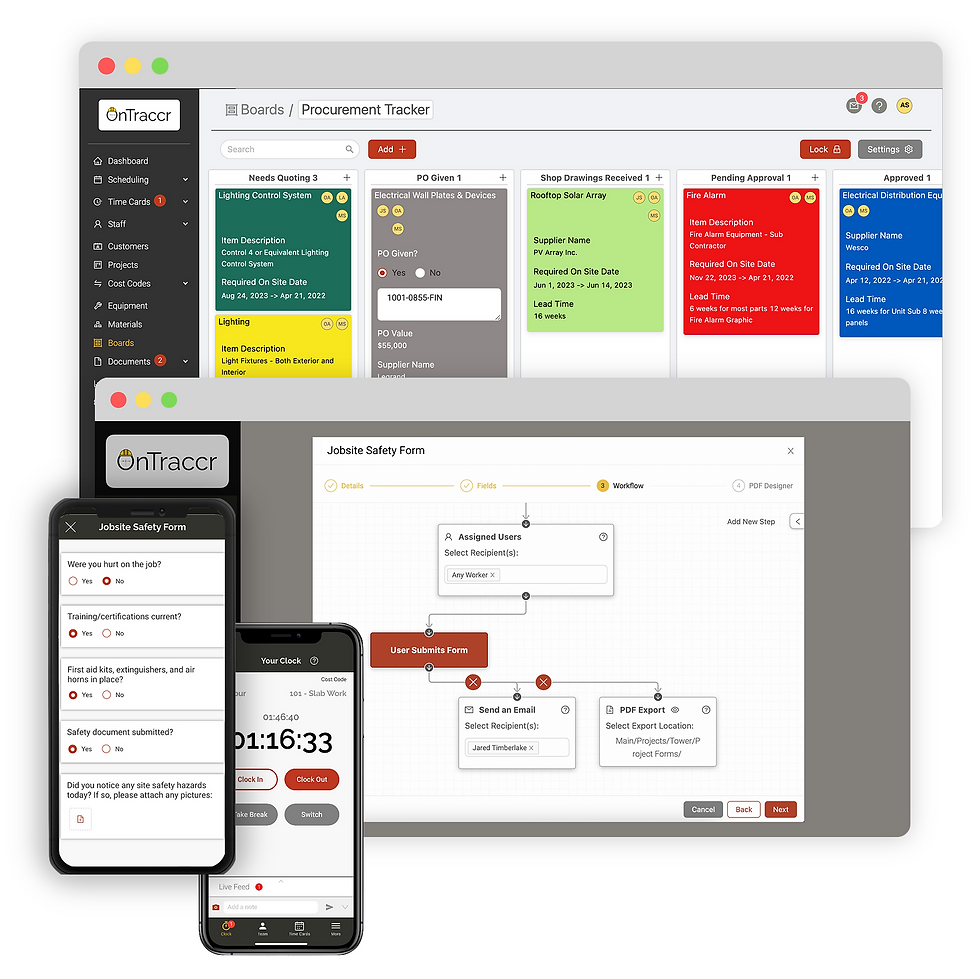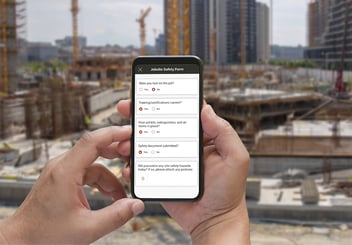Integrating new software into a construction company can be a daunting task, even for the most seasoned professionals. As an expert in the field, I've seen many construction companies struggle to onboard new software due to a variety of challenges.
These challenges can range from resistance to change from employees, to difficulty in understanding how to use the new software or platform. In addition, some companies may face challenges with customization (or lack thereof), compatibility, and even difficulty with knowing where and how to start.
Despite these challenges, it's crucial to keep up with the latest technology trends and integrate new software to stay competitive in the industry. With proper planning and guidance, onboarding new software can be a smooth process that leads to improved efficiency, streamlined workflows, and ultimately, increased profitability.

In this article, I will discuss the crucial steps that all construction companies should take in order to ensure a successful onboarding of a new software platform. By following these steps, you can streamline the onboarding process, reduce resistance to change, and ensure that all employees are comfortable using the new software platform.
Additionally, I will discuss the benefits of choosing a customizable solution like OnTraccr, which focuses on workflow automations, and how it can help construction companies achieve greater efficiency and productivity. By the end of this post, you'll have a clear understanding of how to successfully onboard a new software platform into your construction business.
Step 1: Identify and Define the Goals
The first step in successfully onboarding a construction company onto a new software platform is to identify and define the goals of the software implementation. This step is critical because it sets the foundation for the entire process and helps ensure that everyone is working towards the same objectives.
When identifying goals, it's important to consider what workflows your company is trying to automate or make more efficient. This means taking a close look at your current processes and identifying areas where software can help.
For example, if your company spends a lot of time manually entering data into spreadsheets, then automating data entry may be a top priority. Alternatively, if your company struggles with project management, then a software platform with project management tools may be more important.

Defining the goals of the software implementation helps to prioritize what needs to be onboarded first. By focusing on the most critical workflows first, you can streamline the onboarding process and reduce resistance to change from employees. It also helps to avoid overwhelming employees with too many changes at once.

Choosing a customizable solution like OnTraccr can be especially helpful in this step. With OnTraccr's workflow automation features, you can identify the exact workflows that need to be automated and fully customize the software to meet your specific needs. This can save you time and increase efficiency in the long run.
Step 2: Select the Right Software Platform
When selecting a construction platform, there are several important factors to consider. Customizability is crucial because every construction company has unique needs, and a customizable software platform can be tailored to meet those specific needs. This means that the software can be customized to match the company's branding, as well as to automate specific workflows and processes.
Additionally, a construction platform should have robust workflow management tools that help streamline processes, reduce errors, and improve overall efficiency.
Another key factor to consider when selecting a construction platform is scalability. As your business grows and changes, your software needs may change as well. It's important to choose a platform that can grow with your business, whether that means adding new features or expanding to new areas of the construction industry. This ensures that you won't outgrow your software platform and have to go through the onboarding process all over again.
Finally, it's important to consider the overall user experience. The software platform should be intuitive and easy to use, even for employees who may not be as tech-savvy. It should also provide adequate training and support to help employees get up to speed quickly.
Step 3: Plan and Prepare
Next up in the onboarding process, we have the planning phase. This is where you get to start mapping out all the exciting details of the onboarding process to make sure everything runs smoothly. Trust me, taking the time to prepare now will save you time and headaches down the road!
Firstly, it's important to create a timeline that outlines the entire onboarding process, from start to finish. The timeline should be realistic and account for any potential delays or roadblocks that may arise during the process. It's also important to set realistic deadlines and milestones to help keep the implementation on track.

Roles and responsibilities should also be clearly defined within the implementation plan. This ensures that everyone involved in the onboarding process understands their responsibilities and what is expected of them. It's important to designate a point person who will oversee the implementation process and act as a liaison between the software provider and the construction company.
Finally, communication is also a critical aspect of the implementation plan. It's important to communicate the plan and any updates or changes to all employees who will be affected by the new software platform. This can include regular emails, meetings, and training sessions.
Step 4: Train and Educate Employees
Training and educating employees is critical to the success of the onboarding process. It is essential to provide training and support to employees to ensure they are comfortable with the new software platform.
The training should cover the basic functionalities of the software, how to navigate the platform, and how to access support if needed. Training can be delivered through online courses, webinars, or in-person sessions.
Don't forget to discuss the training and onboarding process with your software vendor before making a purchase. You want to ensure that the software is fully backed up with the necessary training to make the onboarding process as smooth as possible. After all, the last thing you want is to invest in software that your team can't fully utilize due to lack of training.
Step 5: Assign an Internal Champion/PM for Onboarding
Assigning a dedicated onboarding project manager or champion can be a significant help in ensuring a smooth and successful software onboarding process. This person will be responsible for overseeing the onboarding process from start to finish and will act as the point of contact for both the software vendor and the construction company.
Having a dedicated onboarding project manager or champion can help ensure that all parties are on the same page and that the onboarding process is proceeding according to plan. This person can also help coordinate training sessions and provide ongoing support to employees as they learn to use the new software platform.

In addition, a dedicated onboarding project manager or champion can help to identify and address any issues or challenges that arise during the onboarding process. They can work with the software vendor to troubleshoot any technical problems and communicate any concerns to management in a timely and effective manner.
Assigning a dedicated onboarding project manager or champion can help ensure that the onboarding process runs smoothly and that employees feel supported and empowered as they learn to use the new software platform. This can lead to a more successful implementation and improved outcomes for the construction company as the Champion will always ensure that everyone is sticking to the plan.
Step 6: Test and Pilot the Software
A critical step that is often overlooked in the successful onboarding of a construction company onto a new software platform is to test and pilot the software. This involves conducting a thorough evaluation of the software to ensure that it is working as expected and that it meets the needs of your company.
One way to test the software is to run a pilot program with a small group of employees. This allows you to identify any issues or challenges with the software on a smaller scale before implementing it company-wide.
During the pilot program, it's important to gather feedback from the employees using the software to identify any issues or concerns they have. This feedback can be used to fine-tune the software and ensure that it meets the needs of your company.
Another important aspect of testing and piloting the software is to make sure that it integrates well with your existing systems and workflows. This is especially important if you are using multiple software solutions in your operations. Testing the software can help identify any potential compatibility issues and give you time to address them before fully implementing the new platform.
Once you have completed the testing and piloting phase, you should have a clear understanding of how the software works, how it integrates with your workflows, and how it can benefit your business. With this knowledge, you can move forward confidently with the implementation process.
Step 7: Roll Out the Software

When rolling out the software, it's essential to provide adequate training and support to your employees. This will help them to become comfortable and confident in using the new platform. It's important to remember that people learn in different ways, so try to provide a variety of training methods, such as one-on-one sessions, group training, and online tutorials.
During the initial rollout, be prepared to monitor and troubleshoot any issues that arise. Make sure to have a support team available to address any concerns that employees may have. It's important to stay flexible and adjust the implementation plan as needed based on feedback and issues that arise during the rollout.
Step 8: Monitor and Evaluate
The final step in successfully onboarding a construction company onto a new software platform is to monitor and evaluate the performance of the software. This involves tracking key metrics such as user adoption, productivity, and cost savings. It is also important to gather feedback from employees to identify any areas that need improvement.
Pro Tips:
-
Start with a small team: It's always a good idea to start with a small team when onboarding new software. This way, you can work out any kinks before rolling it out to the entire company.
-
Set clear goals and expectations: Setting clear goals and expectations for the software implementation will help ensure that everyone is on the same page and working towards the same objectives.
-
Choose a customizable solution: Choosing a customizable solution like OnTraccr can be incredibly beneficial, as it allows you to tailor the software to meet your specific needs. With OnTraccr's workflow automations, you can automate repetitive tasks, saving time and increasing efficiency.
-
Provide adequate training and support: Providing adequate training and support is critical to the success of the software implementation. Make sure to offer training sessions and provide ongoing support to ensure that everyone is comfortable using the software.
-
Encourage feedback and continuous improvement: Encouraging feedback from employees can help you identify areas that need improvement and make adjustments accordingly. Make sure to listen to feedback and continually work to improve the software and the implementation process.
Final Thoughts
In conclusion, successfully onboarding a construction company onto a new software platform requires careful planning and preparation. It is essential to identify and define the company's goals, select the right software platform, plan and prepare, train and educate employees, test and pilot the software, roll out the software, and monitor and evaluate performance.
With the right approach and strategy, the onboarding process can be seamless and successful, leading to improved productivity, efficiency, and cost savings for your entire company.
For those who are still in the hunt for a new construction platform, OnTraccr is an excellent example of a customizable construction software solution that focuses on workflow automations. With OnTraccr, you can automate repetitive tasks, streamline processes, and increase efficiency and the software is highly customizable, allowing you to tailor it to meet your specific needs.

OnTraccr's intuitive interface and user-friendly design make it easy to use, even for those who are not tech-savvy. Additionally, OnTraccr's team provides excellent training and support to ensure that you get the most out of the software. By choosing a customizable solution like OnTraccr, you can achieve exactly what you want and streamline your construction company's operations.






